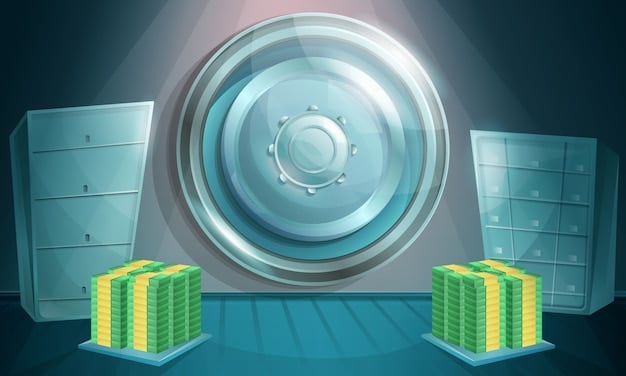Invest in Gold & Precious Metals: A Beginner’s Guide for 2025

How to Invest in Gold and Other Precious Metals: A Beginner’s Guide offers a comprehensive overview of the strategies, benefits, and risks of diversifying your investment portfolio with precious metals like gold, silver, and platinum.
Interested in diversifying your investment portfolio? Learning how to invest in gold and other precious metals: a beginner’s guide is an excellent starting point to understand if this alternative asset class aligns with your investment goals and risk tolerance.
Understanding Precious Metals Investing for Beginners
Investing in precious metals can seem daunting at first, but understanding the basics can make it an accessible option for many investors. Precious metals like gold, silver, platinum, and palladium have served as a store of value for centuries, often acting as a hedge against inflation and economic uncertainty.
This section will cover the core aspects of precious metals investing, offering a solid foundation for beginners to approach this market with confidence.
Why Invest in Precious Metals?
There are several compelling reasons why investors consider adding precious metals to their portfolios.
The Role of Gold in Investment
Gold is often considered a safe haven asset, maintaining or increasing its value during times of economic turmoil. It has a low correlation with other asset classes, offering diversification benefits.
- Hedge Against Inflation: Historically, gold has preserved its purchasing power during inflationary periods.
- Diversification: Adding precious metals can reduce overall portfolio risk by balancing out more volatile assets.
- Store of Value: In times of geopolitical instability, precious metals can retain value when other assets decline.
In conclusion, understanding the basics of precious metals investing is the first step toward potentially diversifying and strengthening your investment portfolio. By considering why these metals are valuable and how they behave during different economic conditions, you can start to assess whether they fit into your overall investment strategy.
Different Ways to Invest in Gold and Precious Metals
There are several ways to invest in gold and other precious metals, each with its own advantages and considerations. Choosing the right method depends on your investment goals, risk tolerance, and the amount of capital you’re willing to invest.
This section will explore the most common options, helping you determine which approach best suits your needs.

Physical Precious Metals
Investing in physical gold, silver, platinum, or palladium involves purchasing the metals in the form of coins, bars, or rounds. This is a tangible investment that you can hold and store.
Precious Metals ETFs and Mutual Funds
Exchange-Traded Funds (ETFs) and mutual funds that focus on precious metals are another popular option. These funds invest in either physical metals or the stocks of companies involved in the mining and production of precious metals.
- Gold ETFs: Track the price of gold by holding physical gold bullion.
- Silver ETFs: Similar to gold ETFs, but focus on silver.
- Mining Company Funds: Invest in companies that mine and produce precious metals.
In conclusion, understanding the different investment methods available is crucial when considering adding precious metals to your portfolio. Each option offers unique benefits and risks, so carefully assess which approach aligns with your investment strategy, risk tolerance, and financial goals before making a decision.
Setting Up Your Investment Account for Precious Metals
Before you start investing in gold and other precious metals, you’ll need to set up an appropriate investment account. The type of account you choose will depend on how you plan to invest and whether you want to hold physical metals or invest through financial instruments like ETFs and mutual funds.
This section will provide a step-by-step guide to setting up your investment account, ensuring you’re ready to take the next steps.
Choosing a Brokerage Account
For investors looking to trade precious metals ETFs or mining company stocks, a standard brokerage account is necessary.
Consider factors like trading fees, research tools, and the range of investment options available when selecting a brokerage.
Setting Up a Self-Directed IRA
A Self-Directed IRA (SDIRA) allows you to hold physical precious metals within a retirement account, offering potential tax advantages.
- Find a Custodian: Choose a custodian that specializes in SDIRAs for precious metals.
- Fund the Account: Transfer funds from an existing retirement account or make annual contributions.
- Purchase Metals: Work with an approved dealer to buy IRS-approved gold, silver, platinum, or palladium.
In conclusion, setting up the right investment account is a fundamental step in your journey to invest in precious metals. Whether you choose a brokerage account for trading ETFs or a Self-Directed IRA for holding physical metals, ensure you select options that align with your investment goals and financial situation.
Evaluating the Risks and Rewards of Investing in Gold
Investing in gold and other precious metals involves both risks and rewards. Understanding these factors is crucial for making informed decisions and managing your investment effectively.
This section provides a balanced overview of the potential benefits and drawbacks to help you assess whether gold aligns with your investment strategy.
Potential Rewards of Gold Investing
Gold has served as a store of value for centuries, often performing well during economic uncertainty.

It can act as a hedge against inflation, currency devaluation, and geopolitical risks.
Risks to Consider
While gold offers potential benefits, it’s important to be aware of the associated risks.
- Volatility: Gold prices can be volatile, especially in the short term, influenced by market sentiment and economic news.
- Storage Costs: Holding physical gold requires secure storage, which can incur additional costs.
- Opportunity Cost: Gold does not generate income like stocks or bonds, so it involves an opportunity cost.
In conclusion, evaluating the risks and rewards of gold investing is essential before making any investment decisions. While gold offers potential benefits as a hedge against economic uncertainty and inflation, it’s important to be aware of its volatility and other associated risks. Balancing these factors with your investment goals and risk tolerance will help you determine if gold is the right addition to your portfolio.
Strategies for Diversifying with Precious Metals
Diversifying your investment portfolio with precious metals involves strategically allocating a portion of your assets to these alternative investments. The goal is to reduce overall portfolio risk and enhance returns by including assets that behave differently from traditional stocks and bonds.
In this section, we’ll explore effective strategies for diversifying with precious metals, helping you build a resilient and well-rounded portfolio.
Determining the Right Allocation
How much of your portfolio should be allocated to precious metals? The answer depends on your individual circumstances, risk tolerance, and investment goals.
Rebalancing Your Portfolio
Rebalancing involves periodically adjusting your asset allocation to maintain your desired proportions. This ensures that your portfolio stays aligned with your investment strategy and risk tolerance.
- Set Rebalancing Intervals: Choose a regular frequency for rebalancing, such as quarterly or annually.
- Monitor Asset Performance: Track the performance of your precious metals investments relative to your other assets.
- Adjust as Needed: Buy or sell assets to bring your portfolio back to its target allocation.
In conclusion, diversifying with precious metals can be a valuable strategy for reducing portfolio risk and enhancing returns. By determining the right allocation, selecting the appropriate investment methods, and rebalancing your portfolio regularly, you can effectively integrate precious metals into your overall investment strategy.
Storing and Insuring Your Precious Metals Safely
If you choose to invest in physical gold, silver, or other precious metals, it’s crucial to have a plan for secure storage and insurance. Protecting your investment from theft, damage, or loss is essential to preserving its value.
This section will explore the best practices for storing and insuring your precious metals, ensuring your investment remains safe and secure.
Secure Storage Options
There are several options for storing physical precious metals, each with its own advantages and costs.
Insurance Coverage
Regardless of where you store your precious metals, it’s important to have adequate insurance coverage. Standard homeowner’s insurance policies may not provide sufficient coverage for valuable items like gold and silver.
- Review Your Policy: Check your existing homeowner’s or renter’s insurance policy to see if it covers precious metals.
- Consider a Rider: If necessary, add a rider or floater to your policy to specifically cover your precious metals.
- Get an Appraisal: Have your precious metals appraised to determine their current value and ensure you have adequate coverage.
In conclusion, safely storing and insuring your precious metals are essential steps in protecting your investment. By choosing the right storage option and obtaining adequate insurance coverage, you can rest assured that your valuable assets are secure and protected from potential loss or damage.
| Key Point | Brief Description |
|---|---|
| 💰 Diversification | Precious metals can reduce portfolio risk by balancing more volatile assets. |
| 🛡️ Hedge Against Inflation | Historically, gold and other metals have preserved purchasing power. |
| 📈 Investment Methods | Physical metals, ETFs, and mining stocks offer varied investment options. |
| 🔒 Secure Storage | Consider vaults, safe deposit boxes, or insured private storage for physical metals. |
Frequently Asked Questions
▼
Precious metals like gold and silver can act as a hedge against inflation and economic uncertainty, diversifying a portfolio and potentially preserving wealth during volatile times.
▼
You can invest in gold through buying physical gold (coins, bars), investing in gold ETFs, mutual funds, or purchasing stocks in gold mining companies.
▼
Safe storage options include home safes, bank safe deposit boxes, and private vaults. Ensure your storage choice is secure and consider insuring your metals against theft or damage.
▼
A Self-Directed IRA allows you to hold physical precious metals in a retirement account for potential tax advantages. You need to set it up through a custodian that handles precious metal IRAs.
▼
Risks include price volatility, storage costs for physical metals, and the opportunity cost of not investing in assets that generate income, such as stocks or bonds.
Conclusion
Investing in gold and other precious metals can be a strategic move for diversifying your portfolio and hedging against economic uncertainties. Understanding the various investment methods, assessing the risks and rewards, and implementing effective diversification strategies are essential for making informed decisions and achieving your investment goals.





